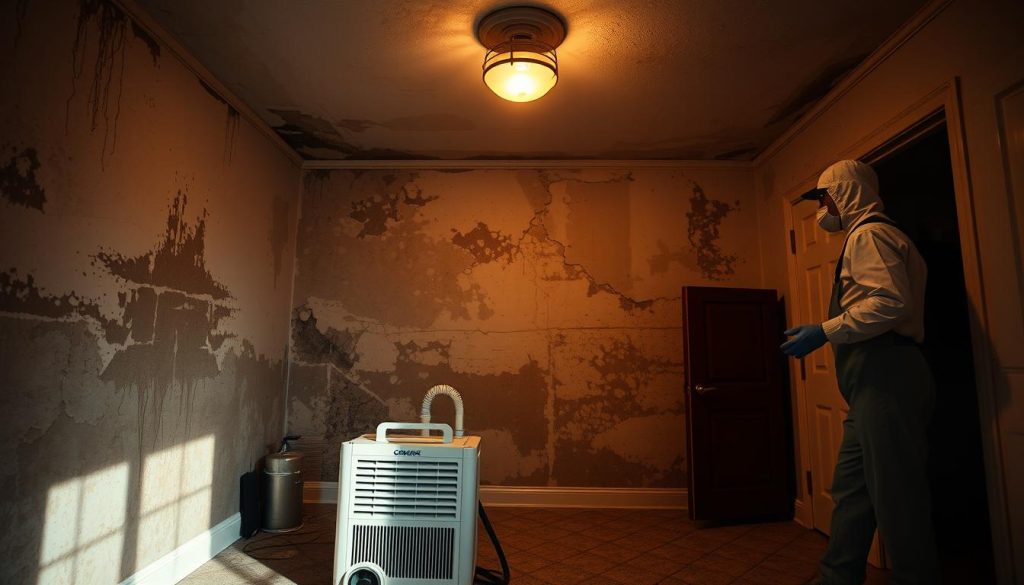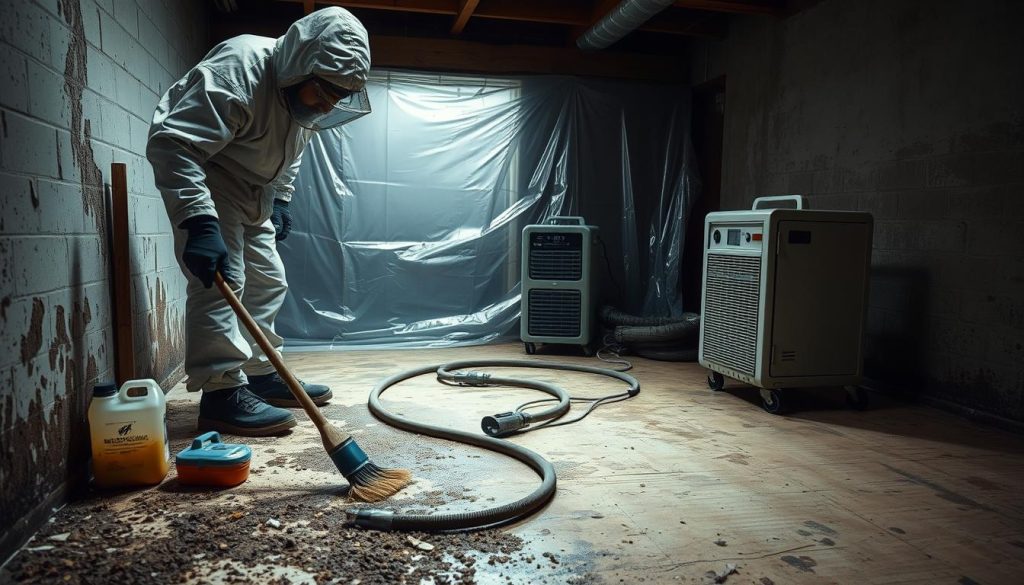You need a clear plan when unwanted growth affects your living space. This introduction explains the full service approach used by a professional company to protect your home, family, and property value.
True remediation goes beyond surface cleaning. It targets sources, controls moisture, contains spread, removes contaminated materials, and restores affected areas to improve indoor air quality.
Trusting professionals matters. DIY attempts can disturb spores, miss hidden pockets behind walls or under floors, and fail to meet compliance and safety standards. A trained team uses HEPA filtration, drying, testing, and documented procedures to reduce recurrence and health risks.
Typical projects often finish in one to five days, depending on severity and location. This Ultimate Guide helps you choose the right steps now to protect your household and long-term investment.
Key Takeaways
- You’ll learn what a full remediation process covers and why it protects home value and health.
- Professionals address root causes, improving indoor air and lowering recurrence risk.
- DIY cleanup can spread spores and miss hidden contamination.
- Expect inspection, containment, removal, HEPA filtration, drying, and testing.
- Most qualified jobs complete in one to five days when handled correctly.
Introduction
If persistent odors, water stains, or unexplained symptoms appear in your living spaces, take them seriously. These everyday clues can point to a hidden problem that affects your air and your family’s health.
You may notice a musty smell, a patch of visible mold, or lingering dampness near a particular area of your home. Even small water events and steady moisture buildup can seed growth behind walls and under floors where you can’t see it.
A professional inspection gives clear answers about where contamination exists, how far it has spread, and which zones need immediate attention. Experts begin by locating and fixing the water source that fuels the issue before isolating work areas.
While mold removal might look simple—wiping a surface—hidden colonies and ongoing dampness can cause a quick return. This guide explains why a full-service approach protects your home value, improves indoor air, and reduces health risks better than DIY attempts.

- You’ll learn inspection steps and practical timelines for professional service.
- Expect containment, drying, testing, and careful restoration as part of a complete plan.
- This overview prepares you to choose safe, reliable help and protect your home and health.
Key Takeaways
Effective treatment targets moisture, containment, and full cleanup—beyond quick surface fixes. This section gives short, high-impact points so you can act with confidence.
Clear definition and scope
Mold remediation is a comprehensive process that finds and fixes the moisture source, isolates affected zones, and removes contaminated materials. It goes far past simple surface cleaning or spot mold removal.
Why it matters
Comprehensive work protects your indoor air quality and reduces recurrence. Proper steps restore structural safety and lower exposure risks that can affect family health.
Professional over DIY
Choosing a professional mold team offers containment protocols, HEPA filtration, and air checks most homeowners don’t perform. DIY efforts can spread spores and miss hidden cavities, making the problem worse.
- Remediation includes containment, removal, and verification—not just visible cleanup.
- Specialized equipment finds root causes and prevents return.
- Documentation and testing give you peace of mind and proof the job was done right.
AI Overview
AI tools now help inspectors spot hidden moisture patterns faster than traditional checks. They analyze sensor readings and inspection notes to map likely growth pathways and prioritize the remediation process sequence for safety and speed.

How AI-assisted assessments support faster detection, documentation, and moisture trend analysis
During pre-remediation inspection, AI flags anomalies in humidity and temperature. This helps you focus on the most at-risk areas first.
AI-driven documentation captures before-and-after photos, logs readings at each inspection point, and summarizes the type of conditions that allow growth so nothing is missed.
Data-driven post-remediation verification to safeguard air quality
Pattern recognition shows where spores may settle and when drying goals are met. During work, AI correlates environmental data with site actions to confirm containment and filtration meet target thresholds.
- Compare post-cleanup air quality against baseline readings to validate indoor air safety.
- Track trends across inspections to reduce recurrence and improve quality control.
- Provide clear, data-backed reports so you can see measurable progress at each milestone.
These tools don’t replace expert technicians. They enhance decision-making, tighten documentation, and give you transparent proof that the remediation process followed best practices and reduced the chance of missed growth.
What Is Mold Remediation
A full-service approach looks beyond quick cleanup to stop recurring growth at its source. First, a professional inspection maps affected areas and finds the water or moisture source feeding the problem.
Comprehensive approach:
- Assessment and targeted inspection to locate hidden colonies and moisture pathways.
- Repair or stabilize the water source, contain the space, and safely remove contaminated porous materials like drywall, insulation, and carpet.
- Cleaning with industry agents, HEPA filtration, drying/dehumidification, restoration, and final verification of indoor air.
Removal versus full remediation
Simple mold removal often means wiping visible spots. That short-term fix can miss unseen colonies and leave the source untouched.
Remediation addresses the root cause, so regrowth is less likely and the property stays healthier and more resilient.
When you need professionals
Consider professional help for visible mold, musty odors, water stains, leaks, warped materials, or health symptoms that improve away from the property.
Because containment, material disposal, and verification matter, rely on trained teams rather than DIY attempts. For practical guidance, see these remediation tips.

The Professional Mold Remediation Process: Step-by-Step
A stepwise protocol prevents airborne spread and ensures contaminated materials leave your home safely.

Professionals begin with a detailed inspection and risk assessment of affected areas and hidden spaces. Meters and visual checks map every zone so the plan targets all contamination, not just visible spots.
Identify and stop the moisture source
Technicians locate and repair the water source to prevent ongoing growth. Without this control, any cleaning is temporary.
Containment and safe removal
Work zones get sealed and negative pressure applied so spores do not travel through the air. Contaminated porous materials are bagged, sealed, and removed for controlled disposal.
Cleaning, filtration, and drying
Surfaces receive antimicrobial treatment and agitation. HEPA air filtration and HEPA vacuuming capture lingering spores during and after work. Drying and dehumidification restore stable humidity so biological activity stops.
Restoration and verification
Teams repair finishes to return the area to pre-damage condition. Final inspection and indoor air testing confirm quality and safety. Hazardous waste is handled per environmental rules to protect you and your community.
Call to Action: Schedule Professional Mold Remediation Today
Act now to protect your household air and property value with a trusted professional team.
DIY cleanup can make contamination worse. You may spread spores, hide growth in cavities, and create larger repairs later.
Why not DIY: exposure risks, hidden growth, and compliance pitfalls
Professional teams use containment, HEPA filtration, and compliant disposal to limit exposure and protect your family. A single certified company handles inspection, source control, cleanup, and restoration with clear documentation.
Timeline expectations: many projects resolve within one to five days
Most jobs finish in one to five days depending on property size and severity. Technicians provide a written plan so you know the schedule, milestones, and verification steps.
- DIY attempts can aerosolize contaminants and spread hidden growth to other rooms.
- Professionals bring containment, HEPA filtration, compliant disposal, and verification.
- Comprehensive remediation services give you one accountable company and full records.
Ready to act? Call Guardian Mold & Restoration at (714) 555-0134 or visit the office at 1250 Magnolia Ave, Suite 300, Anaheim, CA 92801. Book an on-site assessment and receive a written plan tailored to your property and time needs.
Conclusion
A final inspection and air check turn invasive work into lasting protection for your family and property.
Your best outcome comes from a full mold remediation plan that finds the source, contains the area, removes compromised materials, and verifies safe air at the end. Professionals repair water paths, dry and dehumidify, HEPA-filter the space, and restore finishes so damage does not return.
Quick FAQs:
How long? Many jobs finish within one to five days, depending on severity and materials.
Do you need to leave? Sometimes. If containment affects living routes or sensitive people are present, your inspection will advise.
Is testing needed? Yes. Post-work air quality checks confirm the cleanup met documented targets.
Why not just clean the surface? Surface cleaning alone can miss hidden growth and let spores keep affecting indoor air and nearby surfaces. Hire a qualified mold remediation company to protect health, preserve your property, and provide clear documentation of the final quality and restoration.


